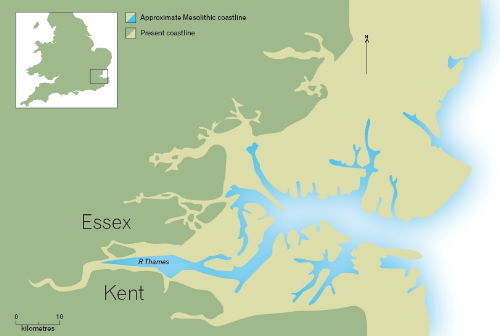10,000 BC to 4,000 BC
Lyn Palmer
Introduction
People returned to Britain about 13,000 years ago after an absence during the extreme cold of the last glaciation. Britain was reoccupied as the climate again warmed up and the last ice sheet began to retreat. The melting ice caused sea levels to rise, rapidly at first, and around 8000 years ago Britain was separated from the continent once more. The area now known as Kent was left as the south-eastern promontory of the island of Britain and was no longer part of the continental landmass.

Image: The Mesolithic coastline c. 6,000 BC
Humans had lived in this country only intermittently during the last Ice Age, when warmer periods allowed. The earliest traces of reoccupation in the county are sparse, despite its potential as a possible gateway into Britain. It is likely that much of the evidence for the earliest reoccupation of the area after the last glaciation lies in the seabed around the south-east coast. The evidence so far is limited to stone tools, usually of flint, since it is readily available in the county. Elsewhere in Europe tools were made from wood, antler and bone but none has yet been found from Kent.
Two flint points, from Oare near Faversham, can be dated on the basis of their form and style to this early reoccupation at the end of the Upper Palaeolithic. At the very end of the Upper Palaeolithic assemblages of long flint blades are found e.g at Springhead, near Gravesend and Riverdale, near Canterbury.
The early post-glacial landscape was probably one of tundra, a cold, dry, treeless plain dominated by mosses and low woody plants. Gradually plants and animals gained a foothold and woodland spread. People began to return in greater numbers.
During the Mesolithic, new tool types evolved. Simple microliths, small and delicately shaped, were sometimes used to fashion composite tools, such as many-barbed harpoons. Tanged points were hafted onto wooden shafts to create arrow tips. No wooden artefacts of this period survive in Kent, but examples from waterlogged sites elsewhere show how wood was used.

Other tools included flint blades with serrated edges and axes, perhaps for woodworking. Some felling of woodland took place, perhaps tempting prey into a clearing of new and tasty growth where it would be easier for the hunters to kill them. The huge animals which had roamed the land during the Ice Ages, such as woolly mammoth, had become extinct, and Mesolithic hunters preyed upon deer, wild boar and other forest-dwelling animals.

Image: Mesolithic scrapers from Newington
Around 9000 years ago, new tool variations appeared, in particular microliths with a hollow base, known as Horsham points. These are found in the south east of England; in Kent from Chiddingstone and Harrietsham amongst other locations.
Tools became even less akin to continental types after the separation of Britain occurred around 8000 years ago. Microliths were increasingly geometric in shape. A greater quantity of finds has been made in Kent from this later Mesolithic period, perhaps because of an increasing population. At Addington, archaeologists excavating a Neolithic tomb found a large quantity of late Mesolithic tools and their manufacturing debris. Axe fragments and resharpening tools have been found at Finglesham, and at High Rocks near Tunbridge Wells, Mesolithic tools were found with hearths, whose material has been carbon-dated to the very end of the period some 6000 years ago. This last site is one of the few places that it is possible to visit and visualise their occupation by Mesolithic people, since they are rock shelters.
Many of Kent’s Mesolithic finds have been made along river valleys, reflecting people’s gravitation towards the available resources of water, fish and fowl.
Mesolithic people were hunter-gatherers, mobile opportunists following animal herds and collecting plant foods, taking advantage of seasonal plenty. There is as yet no evidence that they built permanent structures to live in, and their transitory lifestyle has left little trace.
There is no evidence that Mesolithic people engaged in farming as such, as agriculture really began during the Neolithic. It may be, however, that they protected areas where nutritious cereals were known to grow. At Horton Kirby cereal pollen has been found in a probable Late Mesolithic context, one of only a few examples in the UK of pre-Neolithic cereal cultivation.
Over the next millennia, the lifestyle of Britain’s inhabitants changed gradually, as food gatherers became food producers. The Neolithic had arrived.
